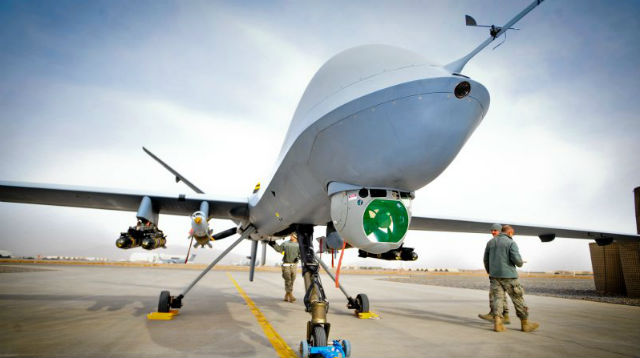The UK's operational use of unmanned air vehicles has reached almost a combined 170,000 flying hours in Afghanistan and previously also in Iraq, its Ministry of Defence has revealed.
A detailed breakdown of the UK's unmanned/remotely piloted air system use was provided following a visit by defence secretary Philip Hammond to the Royal Air Force's Waddington air base in Lincolnshire. This is home to the service's manned intelligence, surveillance and reconnaissance aircraft fleets, and also to a ground control station (GCS), established earlier this year, for its General Atomics Aeronautical Systems Reapers, flown exclusively inside Afghanistan.

Crown Copyright
Controlled from Waddington by 13 Sqn personnel and also by 39 Sqn pilots from Creech AFB in Nevada, the UK's current Reaper force has accumulated more than 54,000 flight hours, the MoD says. Tasks for the five air vehicles currently employed from Kandahar airfield include enabling British forces to "understand the situation on the ground more clearly, develop better intelligence, and precisely strike, within our rules of engagement, those who threaten or hurt the people we are protecting," Hammond says.
The MoD, which has until now kept the doors of its Waddington GCS closed, partly as a result of opposition from some groups to so-called "drone" operations, also reveals that its Reapers had by last month deployed a total of 459 precision-guided weapons: on average once every 120 flight hours. Of this total, 332 were used between 1 December 2010 and 30 November 2013, minister for defence equipment, support and technology Philip Dunne said on 17 December.
On only one occasion has such action resulted in civilian casualties, it says, detailing an incident on 25 March 2011, when two insurgents and four Afghan civilians died when an attack on two pick-up trucks caused a large secondary blast. A subsequent investigation mounted by the NATO-led International Security Assistance Force "concluded that the Reaper crew acted in accordance with established procedures and rules of engagement", it adds.
Of the 170,000h total cited by the MoD, the remainder has been amassed using unarmed systems. The British Army's use of leased Elbit Systems Hermes 450 tactical UAVs has accounted for half of all UK deployed UAS operations, at 85,000h, while the use of Lockheed Martin's hand-launched Desert Hawk series has exceeded 30,000h. Flown by teams tasked with tackling improvised explosive devices, vertical take-off and landing Honeywell Tarantula-Hawks have logged around 550h, while no numbers were provided for the Prox Dynamics-produced Black Hornet micro UAV.
"Much of the criticism of unmanned aerial systems is based on misunderstanding," Hammond says. "This event provides a great opportunity to better inform people about these life-saving assets and their variety of purpose.”
The RAF is to soon start the process of doubling the strength of its Reaper inventory to 10 air vehicles, while the British Army is nearing the delayed service introduction of its Thales UK/Elbit Watchkeeper system. Also including the Royal Navy's pending contractor-supported use of the Boeing/Insitu ScanEagle, the UK's funded investment in UAS is in excess of £1.8 billion ($2.9 billion), the MoD says.
Source: Flight International



















